
The Lord Privy Seal is the fifth of the Great Officers of State in the United Kingdom, ranking beneath the Lord President of the Council and above the Lord Great Chamberlain. Originally, its holder was responsible for the monarch's personal (privy) seal until the use of such a seal became obsolete. The office is currently one of the traditional sinecure offices of state or may be referred to as Minister without Portfolio. Today, the holder of the office is invariably given a seat in the Cabinet of the United Kingdom.

An archdeacon is a senior clergy position in the Church of the East, Chaldean Catholic Church, Syriac Orthodox Church, Anglican Communion, St Thomas Christians, Eastern Orthodox churches and some other Christian denominations, above that of most clergy and below a bishop. In the High Middle Ages it was the most senior diocesan position below a bishop in the Catholic Church. An archdeacon is often responsible for administration within an archdeaconry, which is the principal subdivision of the diocese. The Oxford Dictionary of the Christian Church has defined an archdeacon as "A cleric having a defined administrative authority delegated to him by the bishop in the whole or part of the diocese." The office has often been described metaphorically as that of oculus episcopi, the "bishop's eye".
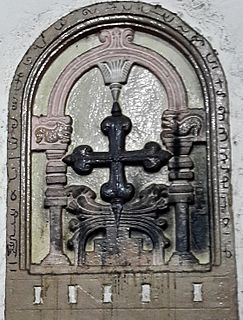
The Synod of Diamper , held at Udayamperoor in June 1599, was a diocesan synod, or council, that created rules and regulations for the ancient Saint Thomas Christians of the Malabar Coast, a part of modern-day Kerala state, India, formally subjugating them and downgrading their whole Metropolitanate of India as the diocese of Angamale, a suffragan see to the Archdiocese of Goa administered by Roman Catholic Padroado missionaries. This synod also introduced many Latin practices in the liturgy of the Saint Thomas Christians which they had been following from centuries. The forced Latinization and disregard for the eastern and local tradition led to a massive protest by Saint Thomas Christians known as Coonan Cross Oath and subsequent schism among them the by mid-17th century.

The Coonan Cross Oath, also known as the Great Oath of Bent Cross, the Leaning Cross Oath or the Oath of the Slanting Cross, taken on 3 January 1653 in Mattancherry, was a public avowal by members of the Saint Thomas Christians of the Malabar region in India, that they would not submit to the Jesuits and Latin Catholic hierarchy, nor accept Portuguese dominance in ecclesiastical and secular life. There are various versions about the wording of oath, one version being that the oath was directed against the Portuguese, another that it was directed against Jesuits, yet another version that it was directed against the authority of Church of Rome
Maximus V was an Orthodox Christian bishop. He was Ecumenical Patriarch of Constantinople from 1946 until 1948.
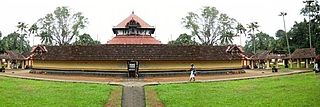
Kaduthuruthy is a town in Kottayam District in the state of Kerala, India.
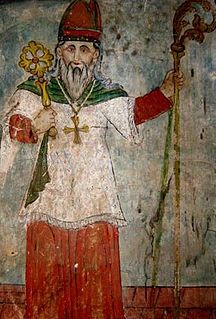
Mar Thoma I, also known as Valiya Mar Thoma and Arkkadiyokkon Thoma in Malayalam and Thomas de Campo in Portuguese was the first native-born, popularly-selected Metropolitan bishop of the Puthenkoor faction of the Saint Thomas Christians or Saint Thomas Christians. He was the last Archdeacon of the undivided St. Thomas Christians of Malankara (Maliyankara).
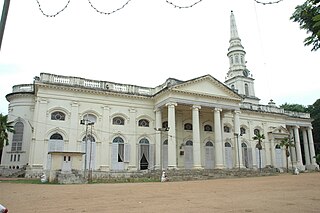
St. George's Cathedral is a Church of South India cathedral in Chennai, India. The cathedral was built in 1815. St. George's occupies an important place in the history of Christianity in India, as the Church of South India was inaugurated here on 27 September 1947. It marked the breaking down of ecclesiastical barriers between Protestants of various traditions.

The Malankara Church, also known as Puthenkur and more popularly as Jacobite Syrians, refers to the collection of West Syriac Saint Thomas Christian denominations, which claim ultimate apostolic origins from the missions of Thomas the Apostle according to tradition. The community under the leadership of Thoma I, that resisted the Padroado Jesuits as well as the Propaganda Carmelites of the Roman Catholic Church, following the historical Coonan Cross Oath of 1653. In 1665, Gregorios Abdul Jaleel, sent from Patriarch Ignatius Abdulmasih I introduced West Syriac Rite in India. By 1809, the Jacobite Syrians fully incorporated the Antiochian Syriac Rite liturgy after the assembly of parish representatives met at Kandanad, Kerala and resolved to fully implement the move to West Syriac Rite through the declaration Kandanad Padiyola, which had been already partially implemented by the same assembly in 1789 at Puthiyacavu. The modern-day descendants of the Jacobite Syrians are the Jacobite Syrian Christian Church (JSCC), the Malankara Orthodox Syrian Church (MOSC), the Malankara Marthoma Syrian Church (MTC), the Syro-Malankara Catholic Church and the Malabar Independent Syrian Church. Among these, only the JSCC form an integral part of the Syriac Orthodox Church of Antioch. The autocephalous MOSC, also known as the Indian Orthodox Church is one of the member churches of Oriental Orthodox communion. The MTC is an independent Oriental Protestant church that is in communion with the Church of England and its Anglican communion. The Syro-Malankara Catholic Church is an autonomus sui iuris Eastern Catholic particular church, in full communion with the Holy See and the worldwide Catholic Church, with self-governance under the Code of Canons of the Eastern Churches.
Ian Hugh White-Thomson was an Anglican priest and Dean of Canterbury from 1963 to 1976.
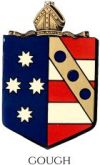
Hugh Rowlands Gough, was an Anglican bishop.
Norman Henry Tubbs was an Anglican bishop in the 20th century.
The Archdeacon of Stow and Lindsey is a senior ecclesiastical officer in the Church of England Diocese of Lincoln.
Kalyan Vaidyanathan Kuttur Sundaram, also referred as K. V. K. Sundaram, was an Indian civil servant, who holds the record as the first Law Secretary (1948–58) of independent India and second Chief Election Commissioner of India. He also chaired the Fifth Law Commission of India for the period 1968–71. He was the principal author of the White Paper which was used to guide the formation of India into states drawn along linguistic lines after its independence. For this, he received personal thanks and high praise from Lord Louis Mountbatten. He was also a Sanskrit scholar, translating for English audiences the works of the Sanskrit writer Kalidasa. A man of humility and discretion, according to The Independent, Sundaram received in 1968 the second highest civilian award which can be bestowed by the Indian Government: the Padma Vibhushan.
Denis James was Archdeacon of Barnstaple from 1946 to 1958.
Edgar Francis Hall was an Anglican priest: the Archdeacon of Totnes from 1948 until 1962.
The Archdeacon of Winchester is a senior ecclesiastical officer within the Diocese of Winchester.
The archdeacons in the Diocese in Europe are senior clergy of the Church of England Diocese in Europe. They each have responsibility over their own archdeaconry, of which there are currently seven, each of which is composed of one or more deaneries, which are composed in turn of chaplaincies.
Harold Edward George Tate was Archdeacon of Bombay from 1948 until 1950.
Brian Harvey (1916-2005) was Dean of Ossory from 1970 to 1991.






